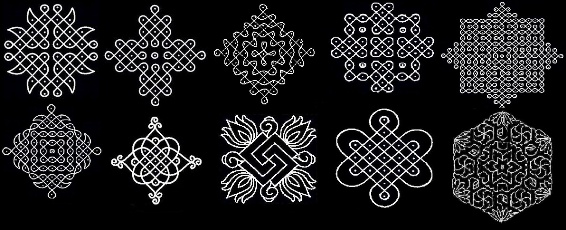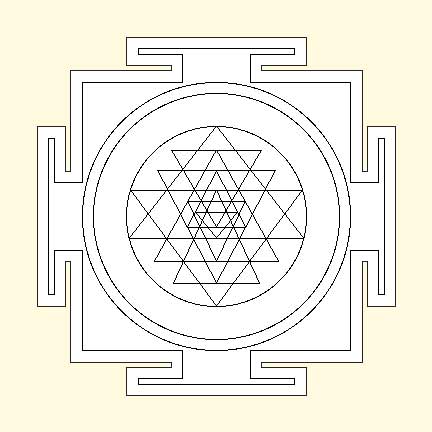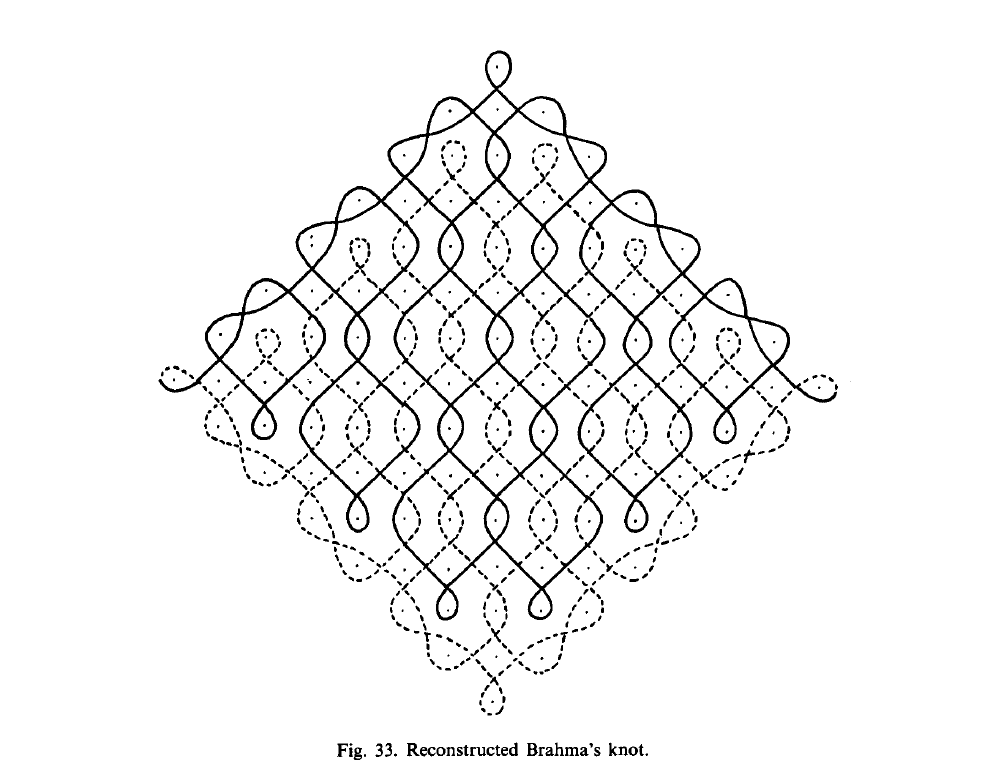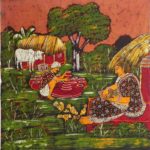
Introduction
Kolams are curved line patterns drawn by the women of Tamil Nadu every morning in front of their houses after sprinkling water and cleaning the ground. Traditionally, this is done using rice flour and is not intended to be a permanent design. Over the day, birds, ants, and tiny insects feed on it, and the wind and footsteps disturb it. The Kolam is disturbed and eventually erased, and the whole cycle is repeated the next day, and the Kolam is reborn.
Kolam patterns are quite fascinating and have caught the attention of researchers worldwide. ‘Ethnographers’ study the Kolam and compare it to ancient designs from other world cultures, while scientists seek to better understand the computing, linguistic, and mathematical rules embedded within these ‘mysterious’ curved lines. Many admire the aesthetic aspect of this female artistic expression. Some are moved to poetry. But it is the Indian woman, from vegetable vendor to ISRO rocket engineer, who have actually practiced and kept the tradition of Kolam alive across centuries. They are connecting with the sacred and the auspicious while creating a new Kolam in front of their home to start off another busy day.
Here are a couple of beautiful Kolam websites that you must visit. Kolams can be done in a variety of different ways. They can be something really simple that takes only a couple of minutes, or they can turn into serious art projects like the one shown in this video below.
In other regions of India, Kolam, especially with colors (e.g. see above video) is known as Rangoli, Rangavalli, etc. Each region has its own distinct version of Kolam or Rangoli. An incomplete list is provided below [1].
- Muggulu (Muggu): Andhra
- Alpana: Bengal
- Puvidal: Kerala
- Chowkpurna: Madhya Pradesh
- Rangoli: Maharashtra, Karnataka
- Mandana: Rajasthan
- Kolam: Tamil Nadu
- Sanjhi: Uttar Pradesh
Women artists in each of these Indian states create Kolam themes that are distinctive and reflective of their regional culture. However, one cannot fail to notice the commonality and consonance between the Rangoli patterns spread all across India, exemplifying India’s unity in diversity. In southern India, Kolams are often drawn daily, while in other places, women may choose to do so during festive occasions. There are also Kolam variations within any given region. For example, in Tamil Nadu, we have Pulli (dot) Kolam, Padi Kolam, etc. Here is a video of a step-by-step construction of a Padi Kolam.
The Kolam structure naturally lends itself to a rich artistic expression. Indeed, the word ‘Kolam’ itself suggests ‘beauty’. It has certain fascinating mathematical properties, as well as a sacred cosmology associated with its construction. Let’s look at all these ideas after a brief review of its history
History of Kolam
Creating paintings on a natural surface has a really ancient history in India, as evidenced by the Bhimbetka frescoes that are at least 15, 000 years old. This news article [2] talks about the use of Rangoli in the Mahabharata while another forum mentions the design in the Ramayana. Other floor designs, such as the endearing floor drawing of the footprints of little Krishna walking into the house during Janmashtami are well known in Indian tradition. One of the 64 arts mentioned in ancient India is तण्डुलकुसुमवलिविकाराः , i.e. Tandula (rice) Kusumavali (array of flowers), Vikara (transformation). This is an art form of organizing an offering of rice and flowers. Rangoli appears to be an instance of this art form. Rangoli is mentioned in the Chitralakshana [3], one of the oldest Indian treatises on paintings, attesting to its ancient origins. In Tamil Nadu, Kolam floor designs were popular during the Chola rule [4].
An article summarizing the amazing work of Dr. Gift Siromoney, a pioneer of Kolam research, comments on the historicity of the Kolam patterns in Tamil literature [5]: “Contrary to popular belief, the common threshold patterns are not very ancient. The practice of decorating the floor may go back to about six hundred years and not more. A few designs may be traced to the Jain temples of South Kanara and at least one to Mahayana Buddhism“. The first conclusion is incorrect. While it may be possible that the usage of the word ‘Kolam’ in Tamil to denote these sacred designs may have been no earlier than 16th century, the actual practice of such floor drawings in Tamil Nadu and other parts of India is ancient, as mentioned earlier. The author is quite right in his second observation that the sacred practice of Kolam is common to all three dharmic systems of India.
Another interesting point mentioned here is that: “To save time in “drawing” the Kolam, many women use devices such as perforated rolling tubes and perforated trays“. We find that attempts to automate Kolam generation were made several decades ago. Of course, such a mechanical device would reproduce a single pattern.
The global research community appears to have noticed the Kolam of Tamil Nadu in 1929 via the work of Mrs. Gnana Durai [3].
Mrs. Durai’s note (source: jstor.org)
A few years later, American anthropologist Layard published a detailed treatise [4] that has been cited extensively. More recent studies done by researchers have covered a wide range of areas including art, computer science, math, sociology, etc.
Kolam Computing
Dr. Gift Siromoney at Madras Christian College co-authored a series of articles on Kolam in the 1970s-80s [5] by analyzing Kolam patterns as a ‘picture language’ in the context of computer graphics, image processing, and theoretical computer science topics. Dr. Siromoney was by all accounts, a remarkable multi-talented personality. His key contributions include:
- A systematic analysis of Kolam that breaks down the construction of any complex design into a finite sequence of simple ‘Kolam moves’, which remains a key idea in Kolam pattern research even today. Based on this analysis, he was able to develop one of the earliest computer programs that could generate multiple Kolam designs.
- Identifying the initial placement of Pullis (dots) to create a grid as a key facilitating step toward rapid Kolam creation.
- A method to determine whether a given Kolam pattern is made up of a single curve (kambi) or multiple lines (multi kambi). He showed how single-line Kolams could be transformed into multi-line Kolams and vice versa, using certain elementary operations that are also noted in Circular DNA Splicing Theory (!). We also note here the single-kambi Kolam connection to an Eulerian graph.
- Experiments that empirically demonstrate that Kolam creation requires skill that can be learned and improved via experience. Seasoned Kolam practitioners were able to store, recall, and more quickly create sophisticated patterns compared to novices.
- Determining that a Kolam practitioner’s skill level had little correlation with their attained level of academic education.
After the pioneering work of Siromoney, a variety of western and Japanese research contributions were published. One of the common goals was the design and analysis of algorithms that could efficiently generate a variety of Kolam patterns. Innovative ideas from math topics ranging from knot theory to topology were employed to come up with methods for generating valid Kolam patterns. Some others tried to enumerate the number of single-kambi Kolam combinations possible for a given number of dots in a grid (not surprisingly, they grow exponentially).
Since the earliest works, several researchers have remarked on the ‘endless lines’ within some Kolams, which we discuss in the next section. Contemporary research is also trying to better understand how single-strand Kolam patterns can be encoded via a ‘sequential language’, i.e. the sequence of gestures employed by Kolam creators. Recently (2011), researchers at SASTRA university in Thanjavur patented a steganographic method (encrypting and transmitting data using an image or pattern), using a pulli Kolam. Note that FIG 2. below resembles a single kambi Kolam. There may also be beneficial applications in the analysis of the Traveling Salesman Problem, a famously difficult problem in Computational Complexity Theory. Clearly, we have a long way to go before we fully decode its magic.

Whereas the western approach to art, science, and math is based on a separate and independent existence of the material and the transcendental world, the Indian approach sees no such dichotomy. Indian art, including Kolam, is rooted in a sacred cosmology, which we examine next.
Cosmology of the Sacred Kolam
Why do Tamil women draw Kolams daily at the threshold of their homes? Why not do something else?
This informative article poses such questions and provides an explanation from a western universal perspective. I present an alternative point of view from my Indian perspective. The linked article also has a nice discussion of the significance of a Kolam’s location at the point of entry into a home. It is clear from this discussion, as well as the history of Rangoli, that these designs involve a sacred transcendental dimension. In Itihasa [1], Rangolis were drawn by the Gopis anxiously awaiting the return of their beloved Krishna, and by the joyous citizens of Ayodhya in anticipation of Rama’s return. Why did they do it?
We can see from Dr. Siromoney’s research, that 16th and 17th century Tamil works record Kolams being drawn prior to a puja invoking Ganapati, the deity who is a remover of obstacles. Today, Kolam drawing in front of their houses remains an integral part of daily life for many Indians, and is also a part of sacred Hindu festivals across India. A deeper understanding of Kolam (and Indian art in general) can be obtained via the traditional Indian approach that views art, science, etc. as not merely secular aesthetic-intellectual subjects, but also as a link to the sacred realm and worthy of reverence. We can recall that the Ganita genius Srinivasa Ramanujan employed this approach while generating truly astonishing results.
From an Indian perspective, we can find not one but several key dharmic ideas embedded within the observations made by various researchers about Kolam. We discuss some of them here.
- Order and Chaos: The harmonious existence of a Kolam and nature within an endless cycle; a gradual dissolution into chaos followed by an equally inevitable restoration of order the next day. Furthermore, there exists within the seemingly complicated ‘spaghetti’ patterns, some really simple and orderly moves that generate them.
- Recursion: for e.g., the fractals identified in the kolam [10]
-

Fractal Kolam: The Anklets of Krishna (source: math.yale.edu)
-
- The idealized Kolam: a single, unbroken line used to create the entire kolam
- The embodied skill required to recall and create complex Kolam designs
The reader is referred to [8] to better understand the first idea. As far as the second concept, many have observed a recursive generating rule pervading Indian art. A similar inductive approach is apparent in various fields such as Sanskrit Grammar (Paninian rules), and Ganita (e.g., Pingala‘s Mount Meru, Hemachandra series, etc.). For example, consider the Hindu representation of the cosmos as the Sri Yantra, which clearly exhibits this recursion. Here’s a simple DIY Sri Yantra Kolam.

The third feature suggests dharma’s integral unity: the externally visible plurality of designs in a single-strand Kolam have no independent existence of their own, but exist within and as a single line (cycle) that has no beginning and end. This also represents the cosmological idea of a Brahma Mudichchu, or Brahma’s knot. Dr. Siromoney travel notes mention that “The South Canara district of Mysore region is studded with Jain temples and each temple has an ornamental flag-staff or dhvaja stambha. The Thousand Pillared Basti at Mudabidare built in the fifteenth century has many ornamental pillars. In some of the pillars there are some complicated designs similar to the Kolam patterns made of unending lines….The unending lines are clearly depicted showing a line superimposed and going over another line at the crossings..” Note that idea of integral unity is common to Hindu, Jain, and Buddhist dharma traditions. In fact, it appears that the Buddha may have been an expert at this art.
Today, multiple independent lines are often used to quickly complete Kolams that become too complex to be completed using a single line. However, mathematicians have been able to recreate elaborate integral Kolam instances (e.g. Pavithram (sacred) is the term used to denote kolams that have ‘never-ending lines’. See the Pavithram design below from [9]) by employing the principles of symmetry and recursion. Similarly, in Indian art, reconstruction of lost art traditions (actual examples include classical dance and poetry) is achieved via the resemblance principle of bandhu. In [8] we learn that “integral unity is not expressed only in terms of divinity and devotion; transcendence to such a state is also available through art. Since time immemorial in India, art has been a way to connect the manifest and the un-manifest, evoking through form the experience that is beyond form.”
This cosmic knot is not only present in Kolams. The knot that binds the three sacred threads (‘Poonal’ in Tamil), as well as the joining together of the ends of the garments of the bride and groom during a Hindu marriage ceremony symbolizing their seamless and unending union, are other instances of a Brahma Mudichchu. The Brahma knot is also present as the deep and sacred Yogic concept of Brahma Granthi in Kundalini Yoga.
A simple answer to the question of ‘why Kolam?’ is ‘why not Kolam’? All Indian art traditions seek to connect with the sacred transcendental and the Kolam is no exception. This reverence has a practical impact. Traditions rooted in sacred practice endure, while those that exclusively rely on the aesthetic or the intellectual become ephemera. Our closing discussion on the fourth and final point shows how sacred Indian practices such as Kolam are preserved and transmitted.
Here is an interesting statement by a Japanese researcher praising the knowledge of Kolam practitioners [11]: “In southern India, there are many great female mathematicians who solve a complicated line pattern every morning, with white rice powder on the ground. The pattern is drawn around a grid pattern of dots so that the lines minimally encircle each dot, which is so called “Kolam” pattern in Tamil.”
Dr. Siromoney was able to practically demonstrate that a Kolam practitioner’s skill is an outcome of what we recognize today as the important Indic tradition of embodied knowing [8]. Dr. Siromoney’s experiments show: “… Expertise in Kolam drawing is, thus of the nature of a skill and exhibits all the attributes that psychologists associate with skill-acquisition and performance.” However, immediately after saying this, the article concludes that “Although the performance of this skill results in products (i.e., Kolam patterns) that possess complex grammatical properties, the practitioners of the skill are themselves unaware of this fact since a large proportion of the practitioners are nonliterate.”
This conclusion can now be recognized as inaccurate. Such decisive dismissals have been repeated by several western researchers, who, after using sophisticated instrumentation to record the amazing results achieved in Yoga and transcendental meditation by Hindu and Buddhist Yogis and monks, labeled them as eastern ‘mystics’ [8], in direct contrast to academy-trained ‘scientists’. Even Srinivasa Ramanujan was not spared since he did not provide a deductive proof for his results. Later, of course, almost all his results were proven by western researchers to be true to their satisfaction.
This confusion can be resolved when we understand that embodied knowing does not require literacy [8] or knowledge of scriptural text, and can be systematically accessed and transmitted in-person from Guru to Sishya, and mother to daughter. This is exactly how Sangeetam and Nrityam (traditional Indian music and dance) is taught via repeated demonstration-replication, where no dance-move textbook or musical score sheet is essential. Arguably, the depth of awareness, knowledge and skill acquired via embodied learning may be more than that achieved by tunneling through mountains of text.
Embodied knowing also democratizes and decentralizes the transmission and reception of knowledge. In fact, it appears that India’s scientific and technical prowess since ancient times until the 1700s was a result of the embodied knowing traditions being passed down from generation to generation by its artisans and engineering communities [8]. The assumption that text-parsing ability is vital to acquiring the deepest knowledge appears to be more typical of Abrahamic tradition, which has been internalized by both secular and religious scholars trained in western academia.
If you haven’t done so before, draw a Kolam at home and teach your kids. Let us rediscover this beautiful Indian tradition, and bring the sacred right to our doorstep and connect to infinity, and beyond!
References
- Pongal Kolam. http://www.pongalfestival.org/pongal-kolam.html (2016).
- Colourful Tradition http://www.thehindu.com/thehindu/mp/2003/01/07/stories/2003010700050200.htm (2003).
- Rangoli History. http://www.rangolidesign.net/rangoli-history.html. 2014.
- Explorations in Applied Geography, edited by Ashok K. Dutt et al. PHI Learning, New Delhi. (2008)
- Dr. Gift Siromoney’s work on Kolam. http://www.cmi.ac.in/gift/Kolam.htm. T. Robinson.
- Preliminary note on geometrical diagrams (kolam) from the Madras Presidency. H. G. Durai, Man, Vol 77 (1929)
- Labyrinth Ritual in Southern India. John Layard. Folklore, Vol 158 (1937).
- Being Different: An Indian Challenge to Western Universalism. Rajiv Malhotra. Harper Collins India. 2011.
- Reconstruction and extension of lost symmetries: Examples from the Tamil of South India. P. Gerdes, Computers & Mathematics with Applications, Vol 12 (1989).
- Thinking in Patterns: Fractals and Related Phenomena in Nature. By Benoit B. Mandelbrot, edited by Miroslav Michal Novak World Scientific Pub Co Inc. (2004).
- Solving Infinite Kolam in Knot Theory. Yukitaka Ishimoto. Computing Research Repository(2007).
Disclaimer: This article represents the opinions of the Author, and should not be considered a reflection of the views of the Indic Civilizational Portal. The Author is responsible for ensuring the factual veracity of the content, herein.

![[Guest Post] Decoding the Intellectual Kurukshetra](https://indicportal.org/wp-content/uploads/2016/02/battlefield-of-kurukshetra-150x150.jpg)


i have wondered about this for so long. thank u so much…
glad you liked it Sejuti ji. Thanks for taking the time to add this note!
Thanks to Sri KV Sarma for sharing this important fact: Michel Danino in his book has a picture of the infinite knot (Brahma knot) found in the ancient Sindhu-Saraswati civilization.
Beautiful! I have heard of a man whose mother sent him a sri yantra cymbal and it healed people.
glad you liked the post. thank you. Very interesting to hear about the Sri Yantra cymbal. Please share more details if possible.
(1) This is awesome! The title itself, connecting (at least on surface) two utterly unlike entities–Kolam and computation, is mind boggling. I didn’t have the faintest idea that the everyday Kolam would be hiding from its average viewer (and admirer) such a deep mystery of cosmic proportions. Let’s have more on this topic please.
(2) I also found the discussion about the meaning and significance of what is known as the ‘endless knot’ very interesting. Dr Srinivas Kalyanaraman in his many publications on the Sindhu/Sarasvati civilization has argued that patterns like ‘endless knot’ that have been recorded on many seals found at Harappa (and also on the Jain ayagapata, a votive slab with intricate patterns resembling rangoli, may be relevant in understanding the depth and richness of metallurgy and such metallurgical processes as smelting ores in ancient India. Perhaps you should contact Dr Kalyanaraman and explore this matter further.
Tilak ji, very happy you like the post! Thanks so much for sharing pointers for exciting research possibilities. I will follow up with Dr. Kalyanaraman after reading up his prior work based on your points. I just came across Dr. Subhash Kak’s book yesterday showing fractal kolam-like patterns in really ancient Indian rock art. Thanks again.
Amazing to read so much about the simple / complicated Kolams that are drawn by the ladies …Big or small, they are associated with austerity and prosperity. Kolams that are drawn with specific designs on specific occasions or rituals are barred from being displayed outside the doorstep on the streets. These include the various Chakras that are drawn for Devi Pooja etc. in Temples or at homes. Bija Mantras to are often infused in some Kolams. These are powerful and have some deep meaning…man is yet to discover.
Years ago, I happened to read a book on Egypt and I stumbled upon the ancient medical practiscs followed by the Priests..and one particulat fact fascinated me..The kolam that we use for decoration very often…the simple one with two triangles superimposed in the opposite directions what Israel has on it’s flag- Triangle of David…is mentioned in this book( unfortunately I have forgeotten the title of this book) ..This pattern was constantly drawn with fingers on a mentally unstable patient’s head and slowly he was cured.Wonder how all these practices have vanished ! Of course there must have been some chants along with this process!!
Thank you for the wonderful articles. I need to read this once more !!
Thanks so much for reading and sharing this fascinating information. Please share the article with your friends and popularize Kolam / Rangoli.
Really very nice designs ! I learned Sankranthi muggulu from my mother in my childhood days. They are very interesting and I also participated in many Rangoli competitions at my school.
Wonderful. Thanks for sharing, reading, and more importantly, for keeping this beautiful tradition going.